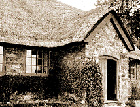Converting redundant chapels
When sensitively converted, redundant historic chapels make characterful homes finds Carla Passino who reveals advice on what to think about prior to converting


There are few period buildings that are as atmospheric as converted chapels. Pointed gables, tall windows and elements of vernacular architecture—unlike churches, chapels of every creed were usually made of local materials using traditional building techniques—all contribute to make them a special place to live. Although there are a number of Anglican and Roman Catholic chapels dating as early as the Middle Ages, the heyday of chapel building in Britain was in the 19th century when Nonconformist churches—such as Baptists, Congregationalists and Methodists—enjoyed a boom in popularity. This was especially true in Wales, where Nonconformism was closely linked to the rebuilding of Welsh identity. 'There are, particularly in some valleys of South Wales, tiny communities with three or four chapels, which in the past would have been all in use,' says a spokeswoman for CADW—Welsh Historic Monuments. Over the last century, however, the flow of people from the countryside into towns and the fundamental change in worship attitudes have made many of these buildings redundant. The most notable examples of chapel architecture are protected by dedicated bodies—England's Historic Chapel Trust, for example, works to preserve, repair and maintain chapels and other places of worship of outstanding architectural and historic interest—but a large number will only survive if they find an alternative use. The ideal solution is for them to serve as village halls or community centres because this is the closest to their original function. In some cases, however, a change of use is required—and a number of chapels are finding new life as private homes. Inevitably, this calls for some adaptation work to make the building suitable for family living. But conversions must be as sensitive as possible—or risk destroying the very essence of a chapel's appeal. In Wales, which has a large number of redundant historic chapels, CADW has put together some guidelines for sympathetic conversions, which apply just as easily to most chapels across the country. Their underlying principle is simple—to conserve 'as much as possible of the building's character and fabric in order to achieve sustainability.' 'You should keep as many features as possible and minimise intrusion,' says Geraint Efans, a Caernarfon-based architect (+44 (0)1286 685483) who converted the Grade-II listed Capel Bethesda, a former Congregationalist chapel in Bethesda, Gwynedd, into twelve flats several years ago. 'After all,' he adds, 'a badly converted chapel looks just like a house with odd bits sticking out.' CADW are adamant that the main front of a chapel should remain as it was conceived, because it is usually its most significant architectural element. If alterations are vitally necessary, they should be kept to 'an absolute minimum.' The rest of the exterior should also be preserved as close to the original as possible by using like-for-like materials and retaining existing doors and windows—or at least their openings—rooflines and name plaques. New doors or windows should be sympathetic to the existing design and the overall volume of the buildings should be kept intact, 'adding as little as possible and demolishing nothing.' Ancillary buildings, gates, railings and other historic elements close to the chapel should also be preserved. Inside, sympathetic partitioning of space is the biggest concern. 'Try to retain as many of the room spaces as possible without destroying their original form,' say CADW. 'Where the principal room is to be sub-divided into smaller spaces this can often be achieved by self-supporting partitions and floors which do not affect the original structure.' To minimise the conversion impact, they recommend allowing 'characteristic features of the chapel to be retained and show through the new walls and floors.' For example, keeping the original entrance vestibule as it was designed is not only sensitive—but also has the added advantage of limiting external noise. Galleries, staircases, panels, decorative ceilings and stained glasses should, in principle, be all kept in position and exposed. Where some original decorative elements really don't fit in, they should be retained and hidden behind reversible elements, such as partition walls, which can easily be removed at the later stage if the use changes again. 'You should try and subdivide space as sympathetically as possible,' explains Efans. 'For example, you could put floors to coincide with window panes or you could get the benefit of a full-height window.' In fact, the trickiest problem he faces when turning historic buildings into homes is not so much making a sensitive use of space as ensuring that it meets modern requirements. 'The most difficult problem is to keep the original windows but increase insulation,' he says. For this reason, both Efans and CADW recommend hiring an architect with specific conversion experience. 'Usually architects can help you work around challenges to do things that are sympathetic but also work,' says Efans. CADW also suggest going to visit a couple of good conversion examples for inspiration. Beyond Efans' Capel Bethesda, they mention Yr Hen Gapel in Pencader, which is now a museum and workshops, and the tiny Ty Capel, in Rhiwddolion, Snowdonia. This was one of the very first chapel conversions and remains one of the very best. And because it is now a holiday cottage owned by the Landmark Trust, it provides the perfect excuse to take a holiday—all in the name of a good architectural cause. Worth noting
Any change of use and alteration to a chapel require planning consent.If a chapel is listed, changes will also require a listed building consentBefore starting any conversion work, it is good practice to take a set of pictures of the chapel in its original state. This is not only an invaluable tool to steer the works in progress but it also has archival value
Sign up for the Country Life Newsletter
Exquisite houses, the beauty of Nature, and how to get the most from your life, straight to your inbox.
Country Life is unlike any other magazine: the only glossy weekly on the newsstand and the only magazine that has been guest-edited by HRH The King not once, but twice. It is a celebration of modern rural life and all its diverse joys and pleasures — that was first published in Queen Victoria's Diamond Jubilee year. Our eclectic mixture of witty and informative content — from the most up-to-date property news and commentary and a coveted glimpse inside some of the UK's best houses and gardens, to gardening, the arts and interior design, written by experts in their field — still cannot be found in print or online, anywhere else.
-
 Diamonds are everyone's best friend: The enduring appeal of one of Nature's sparkliest treasures
Diamonds are everyone's best friend: The enduring appeal of one of Nature's sparkliest treasuresEvery diamond has a story to tell and each of us deserves to fall in love with one.
By Jonathan Self
-
 RHS Chelsea Flower Show: Everything you need to know, plus our top tips and tricks
RHS Chelsea Flower Show: Everything you need to know, plus our top tips and tricksCountry Life editors and contributor share their tips and tricks for making the most of Chelsea.
By Amie Elizabeth White